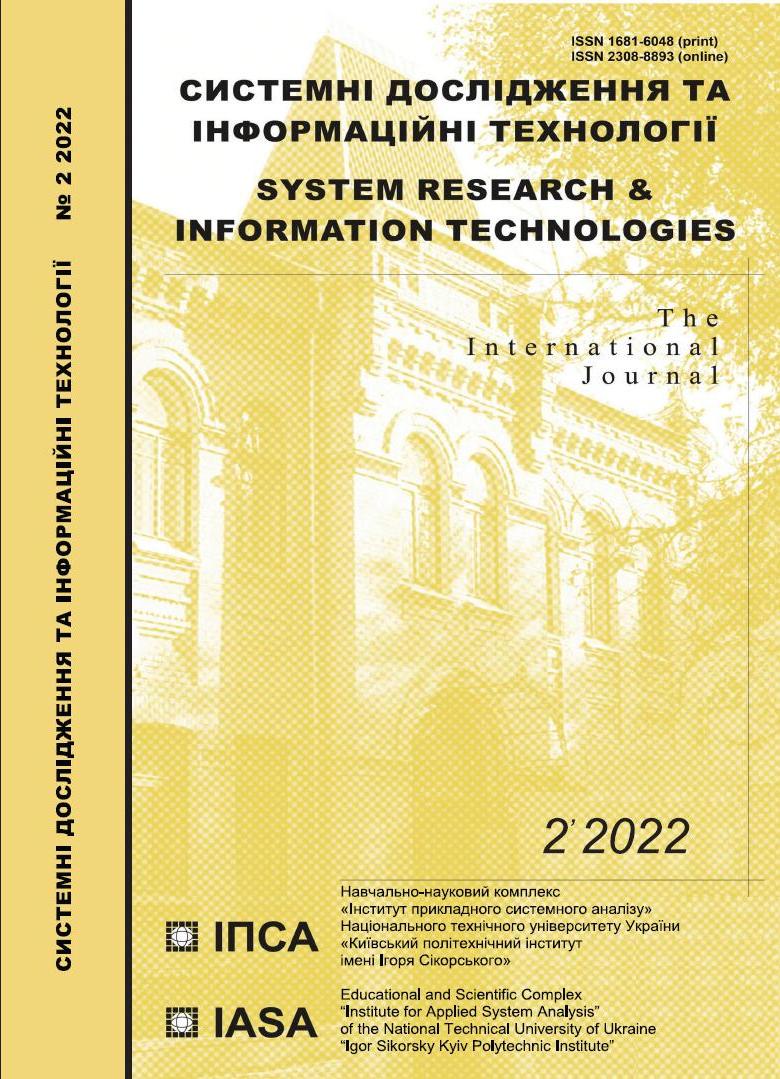Topological optimization of a symmetric single-lap adhesive joint
DOI:
https://doi.org/10.20535/SRIT.2308-8893.2022.2.05Keywords:
three layer construction, topological optimization, genetic algorithmAbstract
The profile optimization problem for layers overlapped with an interjacent adhesive layer is considered. The joint is considered according to the Volkersen model, according to which the base layers are considered as rods that act only in stress-strain, and the adhesive layer acts only in shear. The aim of the optimization is to design a joint structure of minimum mass under the strength restrictions for the adhesive layer and the minimally allowable base layer thickness. The base layers profile is described by a Fourier series expansion. The direct stress state problem for the joint of variable thickness rods is solved by the finite difference method. The optimization problem is reduced to the problem of determining Fourier series coefficients and the joint length. A genetic optimization algorithm was used. The model problem is solved.
References
L.F.M.da Silva, P.J.C. das Neves, R.D. Adams, and J.K. Spelt, “Analytical models of adhesively bonded joints. Part I: Literature survey”, Int. Journal Adhes. & Adhesiv, vol. 29, pp. 319–330, 2009. doi: 10.1016/j.ijadhadh.2008.06.005.
S.S.Kurennov, “Refined Mathematical Model of the Stress State of Adhesive Lap Joint: Experimental Determination of the Adhesive Layer Strength Criterion”, Strength Mater, vol. 52, pp. 779–789, 2020. doi: 10.1007/s11223-020-00231-5.
S.S. Kurennov, K.P. Barakhov, and A.G. Poliakov, “Stressed State of the Axisymmetric Adhesive Joint of Two Cylindrical Shells under Axial Tension”, Materials Science Forum, vol. 968, pp. 519–527, 2019. doi: 10.4028/www.scientific.net/ msf.968.519.
E.H. Wong and J. Liu, “Interface and interconnection stresses in electronic assemblies – A critical review of analytical solutions”, Microelectronics Reliability, vol. 79, pp. 206–220, 2017. doi: 10.1016/j.microrel.2017.03.010.
J. Kupski and S. Teixeira de Freitas, “Design of adhesively bonded lap joints with laminated CFRP adherends: Review, challenges and new opportunities for aerospace structures”, Composite Structures, vol. 268, 113923, 2021. doi:10.1016/j.compstruct. 2021.113923.
R.H. Kaye and M. Heller, “Through-thickness shape optimisation of bonded repairs and lap joints”, Int. Journal of Adhesion & Adhesives, vol. 22, pp. 7–21, 2002.
R.Q. Rodríguez, R. Picelli, P. Sollero, and R. Pavanello, “Structural shape optimization of bonded joints using the ESO method and a honeycomb-like mesh”, Journal of Adhesion Science and Technology, vol. 28:14-15, pp. 1451–1466, 2014. doi: 10.1080/01694243.2012.698112.
H. Ejaz, A. Mubashar, I.A. Ashcroft, E. Uddin, and M. Khan, “Topology Optimisation of Adhesive Joints Using Non-Parametric Methods”, International Journal of Adhesion and Adhesives, vol. 81, pp. 1–10, 2018. doi: 10.1016/j.ijadhadh.2017.11.00.
F. Thamm, “Stress Distribution in Lap Joints With Partially Thinned Adherends”, The Journal of Adhesion, vol. 7:4, pp. 301–309, 1976. doi: 10.1080/002184676080 75061.
Y.S. Karpov, “Jointing of high-loaded composite structural components. Part 2. Modeling of stress-strain state”, Strength Mater, vol. 38, pp. 481–491, 2006. doi: 10.1007/s11223-006-0067-9.
V. Sineglazov, K. Riazanovskiy, and O. Chumachenko, “Multicriteria conditional optimization based on genetic algorithms”, System Research and Information Technologies, no. 3, pp. 89–104. 2020. doi: 10.20535/SRIT.2308-8893.2020.3.07.
Y. Bodyanskiy, A. Shafronenko, and I. Pliss, “Credibilistic fuzzy clustering based on evolutionary method of crazy cats”, System Research and Information Technologies, no. 3, pp. 110–119, 2021. doi: 10.20535/SRIT.2308-8893.2021.3.09.
S. Kurennov, N. Smetankina, V. Pavlikov, D. Dvoretskaya, and V. Radchenko, “Mathematical Model of the Stress State of the Antenna Radome Joint with the Load-Bearing Edging of the Skin Cutout”, International Conference on Reliable Systems Engineering (ICoRSE) - 2021. ICoRSE 2021. Lecture Notes in Networks and Systems, vol. 305, 2022. doi: 10.1007/978-3-030-83368-8_28.
K. Barakhov, D. Dvoretska, and O. Poliakov, “One-Dimensional Axisymmetric Model of the Stress State of the Adhesive Joint”, Lecture Notes in Networks and Systems, vol. 188, pp. 310–319, 2021. doi: 10.1007/978-3-030-66717-7_26.
A. Kondratiev and V. Gaidachuk, “Weight-based optimization of sandwich shelled composite structures with a honeycomb filler”, Eastern-European Journal of Enterprise Technologies, vol. 1(1), pp. 24–33, 2019. doi: 10.15587/1729-4061.2019.15492.
L. Tong and X. Sun, “Shape optimization of bonded patch to cylindrical shell structures”, International journal for numerical methods in engineering, vol. 58, pp. 793–820, 2003. doi: 10.1002/nme.802.
C.H. Wang and A.J. Gunnion, “Optimum shapes of scarf repairs”, Composites Part A: Applied Science and Manufacturing, vol. 40(9), pp. 1407–1418, 2009. doi: 10.1016/j.compositesa.2009.02.009.
S.S. Kurennov, O.G. Polyakov, and K.P. Barakhov, “Two-Dimensional Stressed State of an Adhesive Joint. Nonclassical Problem”, Journal of Mathematical Sciences, vol. 254(1), pp. 156–163, 2021. doi: 10.1007/s10958-021-05295-5.
S.S. Kurennov, “Determining Stresses in an Adhesive Joint with a Longitudinal Unadhered Region Using a Simplified Two-Dimensional Theory”, Journal of Applied Mechanics and Technical Physics, vol. 60(4), pp. 740–747, 2019. doi: 10.1134/s0021894419040199.

